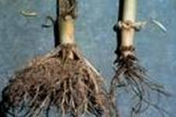Hills
YCD 1, Ooty (FB) 2, Ooty 3 (Pole type) and Premier.
Plains
Arka Komal, (Sel.9) and Premier.
Soil-
Well drained loamy soils with pH range of 5.5-6.0 is required.
Climate –
The optimum temperature is 15-21°C.
Hills : February – March
Plains : October – November
Hills: 80 kg/ha (2 seeds/hill) and 30 x 15 cm.
Plains: 50 kg/ha (2 seeds/hill) and 45 x 30 cm.
Hills: Dig the soil thoroughly and incorporate FYM. Form beds of convenient size.
Plains: After two ploughings form ridges and furrows.
Immediately after sowing, third day and thereafter once a week.
2.Spotted pod borer: Maruca testulalis
| |||||||
Management:
| |||||||
5.Bean Aphids: Aphis craccivora
| |||
Symptoms of damage
Management:
| |||
6.Grass blue butterfly: Euchrysops cnejus
| |
Symptoms of damage
Management of pod borer complex
| |
7.Leaf hopper: Empoasca kerri
| |
Symptoms of damage
Management:
| |
8.Pod bugs: Riptortus pedestris
| |
Management: Spray any one of the following insectcides (Spray fluid 500 l/ha)
| |
9.Lab lab bug or Stink bug: Coptosoma cribraria
| ||
Symptoms of damage
Management-
| ||
10.Whitefly: Bemisia tabaci
| |
Symptoms of damage
Management of sucking pests
| |
11.Blister beetle: Mylabris phalerata
| |
Symptoms of damage
Management
| |
.
1.Root rot and Damping off: Pythium, Rhizoctonia, Macrophomina

| Symptom | |
| |
2.Southern blight: Sclerotium rolfsii

| Symptom | |
| |
3.Cowpea mosaic: Virus

| Symptom | |
Management
| |
4.Fusarium wilt: Fusarium oxysporum

| Symptom | |
Management
| |
